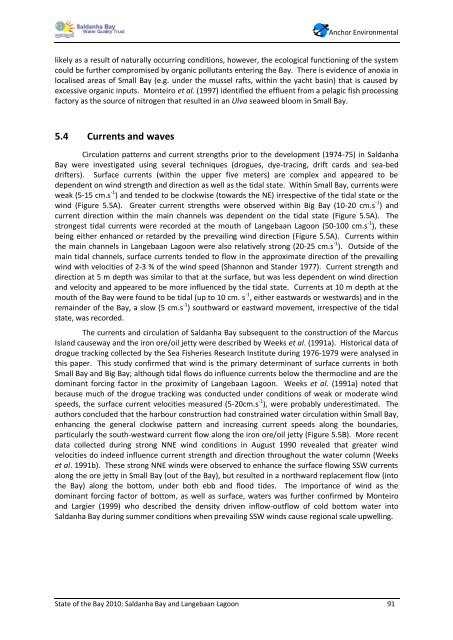State of the Bay Report 2010-Final - Anchor Environmental
State of the Bay Report 2010-Final - Anchor Environmental
State of the Bay Report 2010-Final - Anchor Environmental
You also want an ePaper? Increase the reach of your titles
YUMPU automatically turns print PDFs into web optimized ePapers that Google loves.
<strong>Anchor</strong> <strong>Environmental</strong><br />
likely as a result <strong>of</strong> naturally occurring conditions, however, <strong>the</strong> ecological functioning <strong>of</strong> <strong>the</strong> system<br />
could be fur<strong>the</strong>r compromised by organic pollutants entering <strong>the</strong> <strong>Bay</strong>. There is evidence <strong>of</strong> anoxia in<br />
localised areas <strong>of</strong> Small <strong>Bay</strong> (e.g. under <strong>the</strong> mussel rafts, within <strong>the</strong> yacht basin) that is caused by<br />
excessive organic inputs. Monteiro et al. (1997) identified <strong>the</strong> effluent from a pelagic fish processing<br />
factory as <strong>the</strong> source <strong>of</strong> nitrogen that resulted in an Ulva seaweed bloom in Small <strong>Bay</strong>.<br />
5.4 Currents and waves<br />
Circulation patterns and current strengths prior to <strong>the</strong> development (1974-75) in Saldanha<br />
<strong>Bay</strong> were investigated using several techniques (drogues, dye-tracing, drift cards and sea-bed<br />
drifters). Surface currents (within <strong>the</strong> upper five meters) are complex and appeared to be<br />
dependent on wind strength and direction as well as <strong>the</strong> tidal state. Within Small <strong>Bay</strong>, currents were<br />
weak (5-15 cm.s -1 ) and tended to be clockwise (towards <strong>the</strong> NE) irrespective <strong>of</strong> <strong>the</strong> tidal state or <strong>the</strong><br />
wind (Figure 5.5A). Greater current strengths were observed within Big <strong>Bay</strong> (10-20 cm.s -1 ) and<br />
current direction within <strong>the</strong> main channels was dependent on <strong>the</strong> tidal state (Figure 5.5A). The<br />
strongest tidal currents were recorded at <strong>the</strong> mouth <strong>of</strong> Langebaan Lagoon (50-100 cm.s -1 ), <strong>the</strong>se<br />
being ei<strong>the</strong>r enhanced or retarded by <strong>the</strong> prevailing wind direction (Figure 5.5A). Currents within<br />
<strong>the</strong> main channels in Langebaan Lagoon were also relatively strong (20-25 cm.s -1 ). Outside <strong>of</strong> <strong>the</strong><br />
main tidal channels, surface currents tended to flow in <strong>the</strong> approximate direction <strong>of</strong> <strong>the</strong> prevailing<br />
wind with velocities <strong>of</strong> 2-3 % <strong>of</strong> <strong>the</strong> wind speed (Shannon and Stander 1977). Current strength and<br />
direction at 5 m depth was similar to that at <strong>the</strong> surface, but was less dependent on wind direction<br />
and velocity and appeared to be more influenced by <strong>the</strong> tidal state. Currents at 10 m depth at <strong>the</strong><br />
mouth <strong>of</strong> <strong>the</strong> <strong>Bay</strong> were found to be tidal (up to 10 cm. s -1 , ei<strong>the</strong>r eastwards or westwards) and in <strong>the</strong><br />
remainder <strong>of</strong> <strong>the</strong> <strong>Bay</strong>, a slow (5 cm.s -1 ) southward or eastward movement, irrespective <strong>of</strong> <strong>the</strong> tidal<br />
state, was recorded.<br />
The currents and circulation <strong>of</strong> Saldanha <strong>Bay</strong> subsequent to <strong>the</strong> construction <strong>of</strong> <strong>the</strong> Marcus<br />
Island causeway and <strong>the</strong> iron ore/oil jetty were described by Weeks et al. (1991a). Historical data <strong>of</strong><br />
drogue tracking collected by <strong>the</strong> Sea Fisheries Research Institute during 1976-1979 were analysed in<br />
this paper. This study confirmed that wind is <strong>the</strong> primary determinant <strong>of</strong> surface currents in both<br />
Small <strong>Bay</strong> and Big <strong>Bay</strong>; although tidal flows do influence currents below <strong>the</strong> <strong>the</strong>rmocline and are <strong>the</strong><br />
dominant forcing factor in <strong>the</strong> proximity <strong>of</strong> Langebaan Lagoon. Weeks et al. (1991a) noted that<br />
because much <strong>of</strong> <strong>the</strong> drogue tracking was conducted under conditions <strong>of</strong> weak or moderate wind<br />
speeds, <strong>the</strong> surface current velocities measured (5-20cm.s -1 ), were probably underestimated. The<br />
authors concluded that <strong>the</strong> harbour construction had constrained water circulation within Small <strong>Bay</strong>,<br />
enhancing <strong>the</strong> general clockwise pattern and increasing current speeds along <strong>the</strong> boundaries,<br />
particularly <strong>the</strong> south-westward current flow along <strong>the</strong> iron ore/oil jetty (Figure 5.5B). More recent<br />
data collected during strong NNE wind conditions in August 1990 revealed that greater wind<br />
velocities do indeed influence current strength and direction throughout <strong>the</strong> water column (Weeks<br />
et al. 1991b). These strong NNE winds were observed to enhance <strong>the</strong> surface flowing SSW currents<br />
along <strong>the</strong> ore jetty in Small <strong>Bay</strong> (out <strong>of</strong> <strong>the</strong> <strong>Bay</strong>), but resulted in a northward replacement flow (into<br />
<strong>the</strong> <strong>Bay</strong>) along <strong>the</strong> bottom, under both ebb and flood tides. The importance <strong>of</strong> wind as <strong>the</strong><br />
dominant forcing factor <strong>of</strong> bottom, as well as surface, waters was fur<strong>the</strong>r confirmed by Monteiro<br />
and Largier (1999) who described <strong>the</strong> density driven inflow-outflow <strong>of</strong> cold bottom water into<br />
Saldanha <strong>Bay</strong> during summer conditions when prevailing SSW winds cause regional scale upwelling.<br />
<strong>State</strong> <strong>of</strong> <strong>the</strong> <strong>Bay</strong> <strong>2010</strong>: Saldanha <strong>Bay</strong> and Langebaan Lagoon 91

















